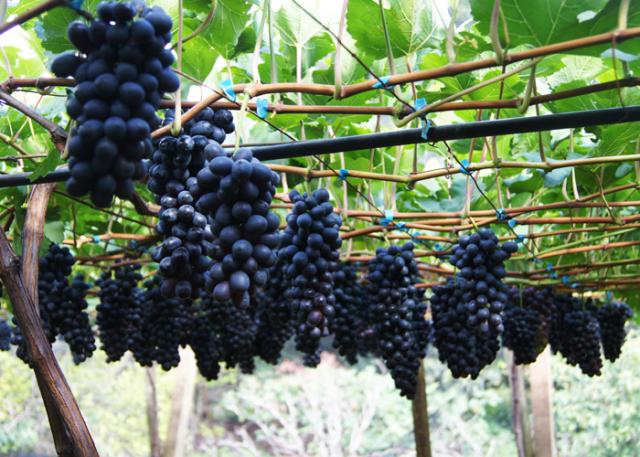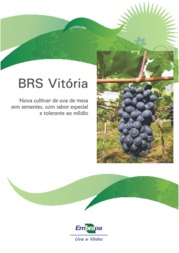Grapes developed for tropical climates win over the UK
Grapes developed for tropical climates win over the UK
A black seedless grape variety that has a special taste and good sweetness-acidity balance is a hit in Europe and has conquered the demanding British market. BRS Vitória is the first Brazilian seedless grape cultivar that is tolerant to mildew, the main fungal disease that attacks vines in the country. Such resistance reduces agrochemical applications in the vineyard.
The new grape's differentiated flavor brought an important competitive advantage to the Brazilian trade balance: grape exports from April to December, making the country claim a good share of the British market, which used to be supplied by grapes from Italy, Spain and Greece at more affordable prices during the period . Nowadays, the Labrunier group alone sends five tons of BRS Vitória weekly to the UK.
The cultivar was especially developed for climate conditions in Brazil within the scope of Embrapa Grape and Wine's Grape Genetic Improvement Program. Recommended for tropical wet climate regions (e.g. Brazilian Southeast) and tropical semi-arid regions, the cultivar has especially stood out in the lower middle section of the São Francisco River Valley, in the cities of Petrolina (Pernambuco) and Juazeiro (Bahia), a region that has been excelling in the market for grape production and exports in Brazil. Launched in 2012, the cultivar has been adopted by 90% of the members of the São Francisco Valley Export Growers Cooperative Union (Cooperativa de Produtores Exportadores do Vale do São Francisco - Coopexvale).
The new cultivar allows for two annual harvests and for planning the time of reaping. Such versatility allows growers to time their production to coincide with market windows of other countries that export to Europe and compete with them with more advantageous prices. The Embrapa researcher João Dimas Garcia Maia, one of the coordinators of the breeding program, explains that with irrigation and the use of products to promote sprouting, it is possible to scale up pruning for the entire year and schedule the harvest for the best market period.
"In tropical conditions, reducing the cycle length leaves the plants resting for 30 to 40 days after successive cycles and also increases sugar accumulation during the maturation stage, which results in sweeter grapes," declares Maia, who emphasizes that the cultivation in tropical weather does not suffer from the limited availability of heat that occurs in crops in temperate climates.
BRS Vitória's tolerance to mildew resulted in economic and environmental advantages. Maia states that the trait is being prioritized in the development of new grape cultivars. "The tolerance facilitates more sustainable production, as it can cut around 20% of fungicide applications, which benefits viticulturists, the environment and consumers", he lists.
Conquering the market
Having worked in the region of Petrolina for 28 years, the entrepreneur Arnaldo Eijsink is attentive to international trends and seeks new cultivars to plant in the Labrunier farms, which belong to the BrasilUvas group. He was one of the pioneers in testing the 'BRS Vitória' in the fields. The grape producer shared his experiece during the lecture "National and international market trends for table grapes", at the XIII Brazilian Congress of Viticulture and Enology.
BrasilUvas is the largest table grape producer of Brazil, with an area of 900 hectares in production and the largest experimental area of new varieties in the world. Nearly 60% of the group's production is traded in the domestic market, while the remainder is sold directly to major retailers in the foreign market like Walmart, Wholefoods, and Loblaws.
Eijsink reports that 'BRS Vitória' was one of the grapes presented on a Field Day event with 30 new grape varieties for potential national and international buyers. "All participants were amazed by the distinguished taste of the cultivar developed by Embrapa ", the businessman recalls.
Mário Gardenalli, chairman of Coopexvale, was one of those responsible for the commercial validation of 'BRS Vitória' and has already been producing the grape for two annual harvests for three years. Gardenalli highlights the distinct taste, the 20% reduction in agrochemicals and the high fertility as the main benefits of the cultivar. "We have managed to have two harvests a year, and each harvest produces 20 to 22 tons per hectare. But what draws the most attention is the grape's flavor, people are pleasantly surprised when they taste it for the first time", he recounts.
The cultivar's acceptance in Brazil is so wide that around 90% of the 22 Coopexvale members, which represent 10% of the cooperative's planted area or 33 of 330 hectares, already produce the cultivar. "We are prospecting the market for 'BRS Vitória' abroad, we have already sent samples to nine of the cooperative's clients", he informs.
Gardenalli remarks that farmers should be attentive to the right time to harvest the cultivar, because as 'BRS Vitória' gets darker and with a high sugar index, it seems to be ready to be picked. "The right time to harvest it is when the grape has no astringency; otherwise, consumers might find the flavor odd. It is important to taste the grape and only harvest it at the right moment", he warned. 'BRS Vitória' was one of the varieties chosen by the cooperative to be traded under their "Gotas de Mel" [Honey Drops] seal due to its sweetness.
According to the researcher João Dimas Garcia Maia, in the São Francisco Valley, the successful adaptation of new cultivars developed by Embrapa, associated with high grape productivity and quality, has encouraged the expansion of the cultivation. "Many vine growers are replacing their canopies (especially 'Itália' group cultivars) for Embrapa's cultivars due to their performance", he comments. It is estimated that nearly 500 ha are already being cultivated with the materials developed by Embrapa: the 'BRS Vitória' cultivar, in around 200 ha; 'BRS Isis', in 100 ha; 'BRS Magna', in 140 ha; and 'BRS Núbia', in about 20 ha.
According to the researcher Patrícia Ritschel, who is also a coordinator of Embrapa's Grape Genetic Improvement Program, 'BRS Vitória' has already been approved for cultivation in the main tropical and subtropical producing regions of Brazil like São Paulo, Paraná, Minas Gerais and the very own Submiddle São Francisco Valley. She reports that the team is working on a management system to enable growers in the Brazilian South to start producing the fruit. "We are adjusting some issues in terms of controling the production and time of harvest, but we believe that in more humid climate regions like the North of Paraná or Rio Grande do Sul, protected cultivation is ideal to avoid ripe rot", she details.
The care with cultivar management in the field, the definition of an ideal point of harvest, and the post-harvest packaging, classification and refrigeration system, associated with a good distribution network, have well positioned Embrapa's cultivars in the market, making it possible for consumers to learn about the new grapes and propelling demand. According to Patricia Ritschel, the 'BRS Vitória' grape produced in Brazilian tropical and subtropical regions has already reached the main supermarket chains in the country's major cities. Maia estimates that the domestic market has currently been the largest consumer of the grape.
BRS Vitória's characteristics
‘BRS Vitória' is a vigorous blue-black grape, that has an early cycle (90 to 135 dias from pruning to harvest, depending on the region) and high bud fertility, with an average of two bunches per branch. The average bunch weight is about 250-300 grams, and berry size, 17 mm x 19 mm. In view of such bud fertility, growers can easily reach the productivity of 30-40 tons per hectare per year. In the São Francisco Valley, in order to obtain high fruit quality, producers are working with two production cycles of 15-20 t/ha/cycle. It has a sugar content that exceeds 19º Brix, which can even reach 23º Brix in tropical regions. It behaves well with regard to berry cracking.
The cultivar's special flavor, its main characteristic, only appears when the grapes are at their ideal point of harvest. Sugar content can reach high levels, but the recommendation is to harvest when the grapes are at least 19º Brix, since that is the moment when the best sugar and acidity balance occurs and gives the grape a special, distinct tase with no astringency in the skin. Once it is picked at such ideal time, 'BRS Vitória' can be conserved for up to 30 days in cold chambers.
Grape Genetic Improvement Program
Embrapa Grape and Wine has led a Breeding Program aimed at obtaining cultivars for processing (wine and juice) and table cultivars since 1977. The researchers seek new cultivars that are better adapted to the different soil and climate conditions in which vines are cultivated in Braxil. The breeding targets high quality and productivity, high tolerance to diseases that attack the crop like downly mildew and powdery mildew, and materials that serve different purposes (table, juice and wine).
The Program makes use of classical breeding methods and maintains a Gene Bank, a collection that gathers nearly 14,000 types of grapes, including cultivated and wild species, varieties, clones and selections. There are three selections at testing stage for wine, three selections for juice, and 38 table grape selections.
In three years, Embrapa is going to start new validation tests with new seedless grape cultivars, including selections with looser bunches and larger berries to reduce labor demand and the use of growth regulators. Within this group, which is undergoing a viral cleaning process, there are white, red and black grapes with different flavors.
Translation: Mariana de Lima Medeiros
Viviane Zanella (MTb: 14004/RS)
Embrapa Grape and Wine
Press inquiries
uva-e-vinho.imprensa@embrapa.br
Phone number: (54)3455-8084
Further information on the topic
Citizen Attention Service (SAC)
www.embrapa.br/contact-us/sac/




